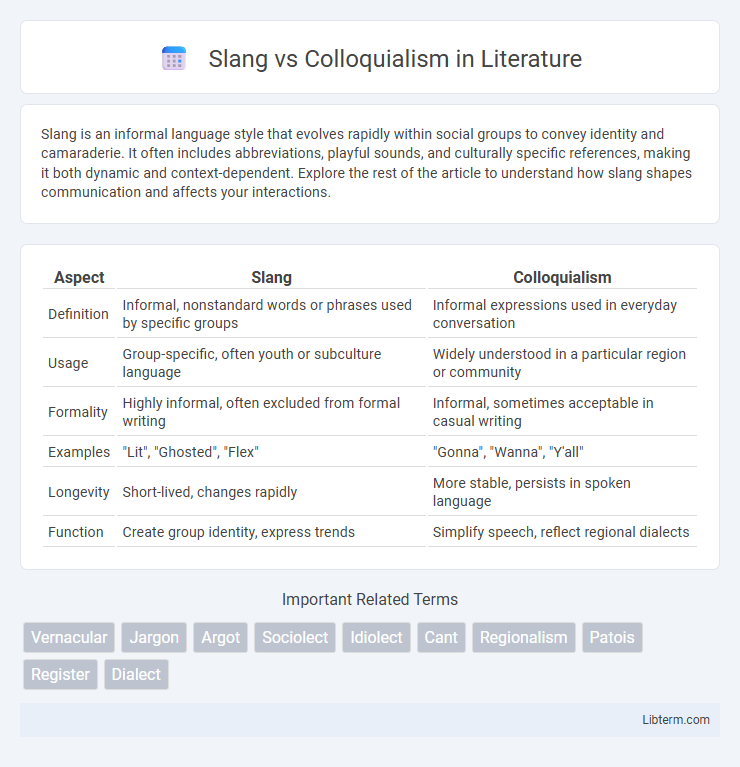Slang is an informal language style that evolves rapidly within social groups to convey identity and camaraderie. It often includes abbreviations, playful sounds, and culturally specific references, making it both dynamic and context-dependent. Explore the rest of the article to understand how slang shapes communication and affects your interactions.
Table of Comparison
| Aspect | Slang | Colloquialism |
|---|---|---|
| Definition | Informal, nonstandard words or phrases used by specific groups | Informal expressions used in everyday conversation |
| Usage | Group-specific, often youth or subculture language | Widely understood in a particular region or community |
| Formality | Highly informal, often excluded from formal writing | Informal, sometimes acceptable in casual writing |
| Examples | "Lit", "Ghosted", "Flex" | "Gonna", "Wanna", "Y'all" |
| Longevity | Short-lived, changes rapidly | More stable, persists in spoken language |
| Function | Create group identity, express trends | Simplify speech, reflect regional dialects |
Introduction to Slang and Colloquialism
Slang consists of informal words and phrases often used within specific social groups or subcultures, creating a sense of identity and exclusivity. Colloquialism refers to everyday informal language that is widely understood within a particular region or community, reflecting common speech patterns. Both slang and colloquialism enrich communication by adding color and cultural context to language.
Defining Slang: What Makes It Unique?
Slang consists of informal words or phrases that emerge within specific social groups, characterized by their playful, innovative, and often rebellious nature. It differentiates itself through rapid evolution, exclusive usage among particular communities, and a tendency to challenge standard language norms. Unlike general colloquialism, slang captures unique cultural identities and frequently serves as a marker of group membership or social belonging.
Colloquialism Explained: Everyday Language in Action
Colloquialism refers to informal language used in everyday conversation, reflecting regional or cultural speech patterns that make communication natural and relatable. Unlike slang, which often includes trendy or group-specific jargon, colloquialisms encompass broader expressions understood by most speakers within a community. This everyday language plays a crucial role in characterizing social identity and cultural nuances in communication.
Key Differences Between Slang and Colloquialism
Slang consists of informal words or phrases often used within specific social groups, typically evolving rapidly and sometimes exclusive to younger generations. Colloquialism refers to everyday conversational language that is regionally or culturally distinctive but more stable and widely understood than slang. The key difference lies in slang's trend-driven, subcultural nature versus colloquialism's broader, place-based linguistic expressions.
Origins and Evolution of Slang
Slang originates from subcultures and marginalized groups as a means of establishing identity and solidarity, often born out of resistance or creativity within social contexts. Its evolution is rapid and dynamic, driven by youth culture, media, and technological advances that spread new terms quickly across communities. Unlike colloquialisms, which are informal but widely accepted within standard language, slang remains transient and more niche, reflecting the shifting nature of social trends and group dynamics.
The Role of Colloquialism in Regional Speech
Colloquialism plays a significant role in regional speech by reflecting local culture, traditions, and social identity, making communication more relatable and authentic within specific communities. It often includes idiomatic expressions and informal phrases that differ from standard language, helping speakers establish a sense of belonging and regional pride. Unlike slang, which tends to be more transient and youth-oriented, colloquialisms are deeply embedded in everyday language and persist across generations in distinct geographic areas.
Social Contexts: When to Use Slang vs Colloquialism
Slang is typically used within specific social groups or subcultures to create a sense of identity and solidarity, often informal and time-sensitive. Colloquialism is more widely understood and used in everyday conversation, reflecting regional dialects or cultural norms without necessarily signaling group membership. Choosing between slang and colloquialism depends on the audience's familiarity and the setting's formality, with slang suited for close-knit, casual interactions and colloquialism appropriate for broader, informal communication.
Slang and Colloquialism in Media and Pop Culture
Slang and colloquialism play a pivotal role in media and pop culture by shaping authentic dialogue and connecting with diverse audiences. Slang, often emerging from subcultures, injects freshness and relatability into lyrics, movies, and social media, reflecting evolving societal trends. Colloquialism grounds narratives in specific regions or communities, enhancing realism and emotional resonance in television shows, films, and literature.
Impact on Communication and Understanding
Slang often alters standard vocabulary with informal, group-specific terms that can create barriers to understanding outside those social circles, impacting communication clarity. Colloquialisms, being regional or cultural expressions, enrich language by reflecting identity but may lead to misinterpretation in diverse audiences. Effective communication requires awareness of these linguistic variations to ensure messages are accurately conveyed and comprehended across different social and cultural contexts.
Conclusion: Embracing Linguistic Diversity
Slang and colloquialism each enrich language by reflecting cultural identity and social dynamics, highlighting the evolving nature of communication. Embracing linguistic diversity through these forms fosters inclusivity and deeper understanding across communities. Recognizing their unique roles enhances appreciation for language's adaptability and vibrancy in everyday interaction.
Slang Infographic

 libterm.com
libterm.com